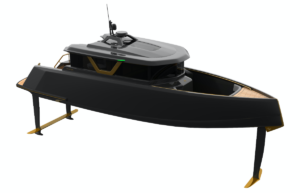NAVAL ARCHITECT PAUL BIEKER FOR ITS FIRST ALL-ELECTRIC HYDROFOIL PERFORMANCE WATERCRAFT
–Navier is a Silicon Valley startup that’s building technology to radically increase the efficiency of small powerboats by 90% while ensuring zero emissions and a superior ride experience.
-The first product is the Navier 27, an all-electric hydrofoil performance craft outfitted with a highly advanced autopilot.
-Navier signed an exclusive agreement with Bieker Boats, a naval architecture firm founded by America‘s Cup renowned naval architect and foiling expert Paul Bieker.
-The Bieker Boats team works on the mechanical design and hydrofoil system of Navier 27 to build the boat of the future.
-Exclusive Q&A with Paul Bieker.
Navier is led by two MIT engineers with extensive knowledge in ocean robotics, aerospace flight controls, and autonomous systems. Co-founders Sampriti Bhattacharyya and Reo Baird recruited Oracle Team USA’s principal design engineer for the 35th America’s Cup, Paul Bieker, as lead naval architect for Navier 27.
Paul Bieker is Seattle-based naval architect and engineer and Founder of Bieker Boats. He is a design expert in hydrofoils and carbon-fiber structures with extensive experience in performance engineering for some of the fastest monohulls and multihulls in the world. Paul worked with Oracle Team USA as a designer since 2003 and was asked to be OTUSA’s principal – design engineer for the 35th America’s Cup in 2017.
Now, Paul is leading Navier’s mechanical design by contributing his knowledge in hydrofoil configuration and foil optimization while leveraging his experience in designing race boats. Paul brings forth valuable intuition and expertise that are key to unlocking the boat’s performance.
“Our goal is to work with the best team possible and we believe Paul is the best expert in hydrofoil technology,” said Co-founder and CEO Sampriti Bhattacharyya. “With Paul’s decades of real world experience in building hydrofoiling crafts and our own expertise in control systems we are ensuring that Navier 27 is the best performance electric craft built till date”
Navier 27 is a 27-foot foiling performance vessel that’s capable of a range exceeding 75 nautical miles under electric propulsion and includes advanced autonomy features. When it launches during the Fort Lauderdale Boat Show 2022, it will be the longest range electric boat in the world. With its hydrofoils, Navier 27 can fly over waves reaching 4 feet high that would otherwise cause uncomfortable pounding; it is 90% more efficient than a traditional 27-foot boat.
“The things that impressed me the most about Navier and their approach to the 27 project is their focus on the technology and getting a boat on the water as efficiently and quickly as possible,” commented Paul Bieker. “It was also clear to me that their experience with innovative marine vehicles, flight control, and robotics will help ensure that the most challenging aspects of the project will get the attention that they require.”
Paul’s experience with performance technology in race boats is valuable in helping Navier achieve its goal to bring clean, efficient waterborne transit to the general public.
Exclusive Q&A with Paul Bieker:
How is working on a recreational boat like Navier 27 similar to working on a racing boat that competes in America’s Cup?
“An America’s Cup effort is similar to the Navier 27 project in that they are both an intense push to get from a clean sheet of paper to a race ready team and boat. They are different in that there is less room for trial and error in the Navier than there is in the America’s Cup’s boats,” commented Paul. “The Navier needs to be dependable and safe from the beginning rather than simply being high performance.”
What are your expectations for Navier 27?
“If we execute the Navier 27 concept to its full potential we will have created a boat that combines high efficiency with comfortable general-purpose accommodations, and a foil arrangement that can handle rougher sea states than any small recreational hydrofoil craft built to date,” said Paul.
How can hydrofoil electric boats disrupt mobility or waterborne transportation as a whole? Do you see potential?
“Marine transportation in the Western world got addicted to cheap fossil fuel based power after the second World War. High output engines and cheap fuel combined with inefficient but capable, heavy deep-vee powerboat hulls became the default way to move fast over water,” said Paul. “In this world, hydrofoiling is a way to move fast over the water while using approximately a third of the power of a conventional high speed boat carrying the same payload.”








